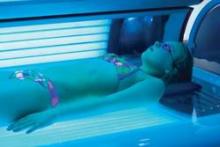MIAMI BEACH – Calls for a ban on the use of tanning beds by minors in the United States have thus far gone unheeded, but medical organizations are increasingly supporting such a ban – and with good reason, according to Alan Geller of the Harvard School of Public Health, Boston.
The data linking tanning bed use and melanoma are consistent and convincing. A 2010 University of Minnesota case-control study, for example, demonstrated that melanoma risk was significantly increased among users, compared with nonusers, of UVB-enhanced tanning devices (adjusted odds ratio, 2.86) and primarily UVA-emitting devices (AOR, 4.44), Mr. Geller said at the annual meeting of the American Academy of Dermatology.
The risk increased as tanning bed use increased (Cancer Epidemiol. Biomarkers Prev. 2010;19:1557-68).
A more recent study demonstrated that with every visit to a tanning bed, the risk of melanoma increased by 1.8% – and the risk was even greater among those who started tanning at a younger age (BMJ 2012;345:e4757).
"We are clearly in the throes of a modern-day epidemic, particularly among teenage white girls and young women between the ages of 18 and 25," Mr. Geller said, noting that study after study shows that about a third of white teenage girls and about 20% of all teenage girls use a tanning bed by the age of 17.
And yet only five states restrict the use of tanning beds by those under age 18. Others have parental consent restrictions, but these have been shown to have no effect on tanning bed use by minors. That means that in 45 states, children aged 15 years and younger are free to visit tanning salons with no restrictions, he said, noting that a Washington University in St. Louis survey released in February showed that 65% of Missouri tanning salon owners would allow preteens aged 10-12 years to use their tanning beds – and that 43% of tanning salon employees believe indoor tanning poses no health risks.
Data show that 7% of girls use tanning beds by age 14 years. This doubles from age 14 to 15, and doubles again from age 15 to 17, he said, noting that girls are about five to six times more likely than boys to use tanning beds.
Of particular concern, not only are girls using tanning beds early, but they are using them more often.
A Centers for Disease Control and Prevention survey showed that while the rate of use (20% among all girls) has remained constant in recent years, the "prom phenomenon" – the occasional use of tanning beds before a special event – is no longer the norm; the average yearly number of uses of tanning beds among those surveyed was 28.
"We’re way past the prom phenomenon," Mr. Geller said, noting that one reason for this is that tanning salons "do a wonderful job of selling giant packages of use for very little money."
"When people are beginning to think of some kind of restrictions on the tanning bed industry, that would be one we could surely consider," he said, noting that based on the data showing a 1.8% increase in melanoma risk with each tanning bed use, the risk would be 54%-90% in a teen who starts tanning at age 18 and quits at age 19.
That’s a conservative estimate, because most teens start before age 18 and don’t stop at age 19, he said.
Surveillance, Epidemiology, and End Results (SEER) data from the National Cancer Institute show that the risk of melanoma has doubled among women aged 20-24 years since the 1980s, while the risk in men has declined in some age groups, and remained the same in others.
"You have to ask what’s happened during that time," Mr. Geller said, adding that there is concern about the late effects of tanning bed use, especially given that sun exposure time hasn’t changed in that age group over time.
As for what can be done from a public health perspective to reduce tanning bed use, Mr. Geller said a number of research, legislative, and public health campaigns are underway.
"We know from doing qualitative work, that indoor tanning is largely socially driven. "When [girls] are not tanning, they talk about tanning, they blog about tanning," he said, explaining that "the tanning culture involves some kind of socially driven bonds."
The key is to figure out how to break up those bonds.
"If one girl in a social group quits tanning, will this have an effect on the others? We don’t know," he said, adding that this is among the areas that require further research.


